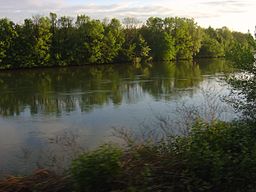Drau
| Drava | |
| Drau, Drave, Dráva | |
| River | |
|
Drava near Ormož, Slovenia
|
|
| Countries | Italy, Austria, Slovenia, Croatia, Hungary |
|---|---|
| Cities | Lienz, Spittal an der Drau, Villach, Ferlach, Dravograd, Vuzenica, Muta, Ruše, Maribor, Ptuj, Ormož, Varaždin, Osijek, Barcs |
| Source | North of the Neunerkogel over the Toblacher Feld |
| - location | Toblach, South Tyrol, Italy |
| - elevation | 1,450 m (4,757 ft) |
| - coordinates | 46°43′9″N 12°15′16″E / 46.71917°N 12.25444°E |
| Mouth | Danube near Osijek |
| - coordinates | 45°32′38″N 18°55′31″E / 45.54389°N 18.92528°ECoordinates: 45°32′38″N 18°55′31″E / 45.54389°N 18.92528°E |
| Length | 749 km (465 mi) |
| Basin | 40,120 km2 (15,490 sq mi) |
| Discharge | |
| - average | 670 m3/s (23,661 cu ft/s) |
|
Map of Drava River
|
|
The Drava (German: Drau; Hungarian: Dráva) or Drave is a river in southern Central Europe. With a length of 749 kilometres (465 mi), it is the fourth longest tributary of the Danube. Its source is near the market town of Innichen (San Candido), in the Puster Valley of South Tyrol, Italy. The river flows eastwards through East Tirol and Carinthia in Austria into the Styria region of Slovenia. It then turns southeast, passing through Croatia and forming most of the border between Croatia and Hungary, before it joins the Danube near Osijek.
In ancient times the river was known as Latin: Dravus, cf. Sanskrit: द्रवति, dravati, "flow". The name is most likely of Celtic or Illyrian origin (see Old European hydronymy). The river gives its name to the dravite species of tourmaline.
The Drava (along with one of its tributaries, the Slizza) and the Spöl are the only two rivers originating in Italy that belong to the Danube drainage basin. The Gail in Austria, the Meža and Dravinja in Slovenia, and the Bednja in Croatia from the south, as well as the Möll, the Gurk and the Lavant in Austria, and the Mur (near Legrad) in Croatia from the north are its main tributaries.
...
Wikipedia


